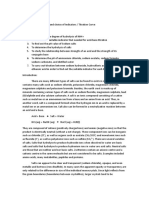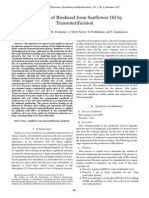CHEMY102 Lab4 Hydrolysis of Salts
CHEMY102 Lab4 Hydrolysis of Salts
Uploaded by
rafiudinmohdCopyright:
Available Formats
CHEMY102 Lab4 Hydrolysis of Salts
CHEMY102 Lab4 Hydrolysis of Salts
Uploaded by
rafiudinmohdOriginal Description:
Copyright
Available Formats
Share this document
Did you find this document useful?
Is this content inappropriate?
Copyright:
Available Formats
CHEMY102 Lab4 Hydrolysis of Salts
CHEMY102 Lab4 Hydrolysis of Salts
Uploaded by
rafiudinmohdCopyright:
Available Formats
Chemistry
Lab Report
Experiment Number 4
CHEMY 102
Rafiuddin Mohammed Mohiuddin
( (
ID number: 20135673
Section 05
Name: Rafiuddin Mohammed ID: 20135673 CHEMY 102, Section 05
Chemistry Lab Report
Experiment No. 4
HYDROLYSIS OF SALTS AND THE ACTION
OF A BUFFER SOLUTION
Aim:
The purpose of this experiment is to learn about the concept of
hydrolysis and to gain familiarity with the behavior of buffer
solutions.
PTO
Results and Calculations:
Experiment 4: HYDROLYSIS OF SALTS AND THE ACTION OF
A BUFFER SOLUTION
REPORT SHEET
A. Hydrolysis of Salts
Table I
Solution
(0.1 M)
Ion expected
to hydrolyze
Spectator
ion(s)
NaCl
---
Na
+
, Cl
-
Na
2
CO
3
CO
3
2
Na
+
NaC
2
H
3
O
2
C
2
H
3
O
2
-
Na
+
NH
4
Cl
NH
4
+
Cl
-
ZnCl
2
Zn
2+
Cl
-
KAl(SO
4
)
2
Al
3+
K
+
, SO
4
2
Table II
Solution pH [H
+
] [OH]
Color of the Indicator
Phenolphthalein
H
2
O (unboiled) 6.96 1.1 x 10
-7
0.9 x 10
-7
Colorless
H
2
O (boiled) 7.04 0.9 x 10
-7
1.1 x 10
-7
Colorless
NaCl 7.28 0.5 x 10
-7
2 x 10
-7
Colorless
Na
2
CO
3
11.85 1.4 x 10
-12
7.1 x 10
-3
Pink
NaC
2
H
3
O
2
7.55 0.3 x 10
-7
3.3 x 10
-7
Colorless
NH
4
Cl 5.86 13.8 x 10
-7
7.2 x 10
-9
Colorless
ZnCl
2
5.52 3.0 x 10
-6
3.3 x 10
-9
Colorless
KAl(SO
4
)
2
2.96 1.1 x 10
-3
9.1 x 10
-12
Colorless
Table III
Solution
(0.1 M)
Net-ionic equation for
hydrolysis
Expression for equilibrium
constant (K
a
or K
b
)
Value of
K
a
or K
b
Na
2
CO
3
CO
3
-
(aq) + H
2
O HCO
3
-
(aq) + OH (aq) K
b
= [HCO
3
-
] [OH] / [CO
3
-
] K
b
= 5.0 x 10
-4
NaC
2
H
3
O
2
C
2
H
3
O
2
(aq) + H
2
O HC
2
H
3
O
2
(aq) + OH
(aq)
K
b
= [HC
2
H
3
O
2
] [OH] /
[C
2
H
3
O
2
]
K
b
= 1.1 x 10
-12
NH
4
Cl
NH
4
+
(aq) + H
2
O NH
3
(aq) + H
+
(aq) K
a
= [NH
3
] [H
+
] / [NH
4
+
] K
a
= 1.9 x 10
-11
ZnCl
2
Zn
2+
(aq) + H
2
O Zn(OH)
+
(aq) + H
+
(aq)
K
a
= [Zn(OH)
+
] [H
+
] / [Zn
2+
] K
a
= 9.0 x 10
-11
KAl(SO
4
)
2
Al[H
2
O]
6
3+
(aq) Al[H
2
O]
5
[OH
-
]
2+
(aq) +
H
+
(aq)
K
a
= [Al[H
2
O]
5
[OH
-
]
2+
] [H
+
] /
[Al[H
2
O]
6
3+
]
K
a
= 1.2 x 10
-5
B- The Action of a Buffer Solution
Table IV
Volume (total)
/ mL
pH on addition of
0.1 M NaOH to
pH on addition of
0.1 M HCl to
buffer pure water buffer pure water
0.0 7.46 7.60 7.44 7.20
1 drop 7.48 9.44 7.42 6.83
1.0 mL 7.56 11.36 7.31 2.92
5.0 mL 8.28 11.80 6.85 2.25
Discussion:
The experiment enlightens us to the reason behind the acidity or basicity of a
solution at the equivalence point. The reason is easily explicable by the
concept of hydrolysis.
The salt formed by the reaction between a strong acid and a strong base is a
neutral salt and does not undergo hydrolysis. This is why titration between a
strong acid and a strong base gives a neutral equivalence point. Similarly,
titration between a strong acid and a weak base OR a weak acid and a strong
base gives an acidic OR basic equivalence point because of the hydrolysis of
the cation OR anion of the respective salts.
Buffers are interesting solutions because of their resistance to high changes
in pH. They are found in various natural systems and are of great value even
in our own body.
These experiments, conducted to determine the acidity and basicity of the
various salts give values for their dissociation constants that are, at best,
gross approximations. This is because of the various errors involved that
include the presence of CO
2
in the atmosphere which dissolves in the
solutions and changes the pH, the inaccuracy of the pH meter in giving
readings, the improper cleaning of the containers in which the measurements
are taken, the possible incomplete immersion of the electrode in the solution,
etc.
The experiment could have been better conducted by using freshly prepared
solutions of the salts, using a fast and accurate pH meter, carefully making
the measurements, and cleaning the apparatus before each reading.
Conclusion:
Knowing the pH of a salt solution is an important aspect of various
processes and studying hydrolysis is consequently of significant importance.
You might also like
- Hydrolysis of Salt and PH of Buffer Solutions.Document16 pagesHydrolysis of Salt and PH of Buffer Solutions.amiraaikharah100% (1)
- Kukdo YD-128Document6 pagesKukdo YD-128Abid AliNo ratings yet
- HYDROLYSIS OF SALTS AND PH OF BUFFER SOLUTIONSDocument13 pagesHYDROLYSIS OF SALTS AND PH OF BUFFER SOLUTIONSfadz607100% (2)
- Pre-Reg Calculation Session - DilutionDocument16 pagesPre-Reg Calculation Session - DilutionNotForAbuse100% (2)
- Laboratory Report CHM 213 (Physical Chemistry) : 1. Muhammad Mirza Hizami Bin RajieiDocument6 pagesLaboratory Report CHM 213 (Physical Chemistry) : 1. Muhammad Mirza Hizami Bin RajieiMuhd Mirza Hizami100% (2)
- Experiment 7Document11 pagesExperiment 7Stefan Marco RumenganNo ratings yet
- Biochemistry Applied to the Brewing Processes - Mashing, Boiling, CoolingFrom EverandBiochemistry Applied to the Brewing Processes - Mashing, Boiling, CoolingNo ratings yet
- Organometallic Transition Metal Catalysis: A Holistic Approach to Understanding and Predicting their MechanismsFrom EverandOrganometallic Transition Metal Catalysis: A Holistic Approach to Understanding and Predicting their MechanismsNo ratings yet
- Analytical Chemistry ExercsisesDocument7 pagesAnalytical Chemistry ExercsisescallielizzaNo ratings yet
- Acid Bases and Salts MCQ QuestionsDocument10 pagesAcid Bases and Salts MCQ Questions09whitedevil90No ratings yet
- Module 6 - Acid and Base Reactions NotesDocument43 pagesModule 6 - Acid and Base Reactions NotesKristy LamNo ratings yet
- Week 3..Document20 pagesWeek 3..ALPHEAUS-MBA AwajibenejiNo ratings yet
- Hydrolysis of Salt and The Action of Buffer SolutionDocument5 pagesHydrolysis of Salt and The Action of Buffer SolutionFaisal MumtazNo ratings yet
- Experiment 20:: Determination of PH of Common SubstancesDocument7 pagesExperiment 20:: Determination of PH of Common SubstancesRyan CrisostomoNo ratings yet
- Liquid Phase Esteri®cation of Acrylic Acid With 1-Butanol Catalyzed by Solid Acid CatalystsDocument9 pagesLiquid Phase Esteri®cation of Acrylic Acid With 1-Butanol Catalyzed by Solid Acid CatalystsHolman SanabriaNo ratings yet
- Experiment 15. Acids, Bases, Salts and Buffers: Objective: 1. To Understand An Acid-Base ReactionDocument6 pagesExperiment 15. Acids, Bases, Salts and Buffers: Objective: 1. To Understand An Acid-Base ReactionNathan Ray AlimNo ratings yet
- CHEM Lab 6-11Document34 pagesCHEM Lab 6-11HADI100% (1)
- Waste ProcessDocument86 pagesWaste ProcessacidoanimalNo ratings yet
- CH1202 LabManual 2024Document46 pagesCH1202 LabManual 2024flowerkamal12No ratings yet
- معايرة حامض الهيدروكلوريك انكليزيDocument17 pagesمعايرة حامض الهيدروكلوريك انكليزيأحمد غالب مهدي - مسائي C-1No ratings yet
- Laboratory Manual CHE102 Chemistry LabDocument41 pagesLaboratory Manual CHE102 Chemistry LabSushil KumarNo ratings yet
- Botp - Basic ChemistryDocument23 pagesBotp - Basic ChemistryjtichemicalNo ratings yet
- Experiment 3Document14 pagesExperiment 3Jackson Ng Chee Yang100% (1)
- Lab Report 9Document6 pagesLab Report 9api-252715546100% (1)
- Report On Hardness of WaterDocument11 pagesReport On Hardness of Waterbharon4businessNo ratings yet
- QPSolution CH 2 DT 03 06 2024 6320248192607Document4 pagesQPSolution CH 2 DT 03 06 2024 6320248192607james shahNo ratings yet
- BTVN1Document3 pagesBTVN1217058 Nguyễn Thị Thùy LinhNo ratings yet
- Alkalin & PHDocument15 pagesAlkalin & PHSergio VivasNo ratings yet
- PH Determinations of SolutionDocument8 pagesPH Determinations of SolutionMaryam JabiyevaNo ratings yet
- Analytic ChemistryDocument115 pagesAnalytic ChemistryRalyn BasisNo ratings yet
- AnachemDocument115 pagesAnachemRochie DiezNo ratings yet
- Acids & Bases: General Chemistry 101Document39 pagesAcids & Bases: General Chemistry 101aiden limNo ratings yet
- Experiment 1Document24 pagesExperiment 1Joanna Liezl AbrinaNo ratings yet
- PBJL_mergedDocument30 pagesPBJL_mergedNajwa ShauqiyahNo ratings yet
- Mini Research Kimia 2Document14 pagesMini Research Kimia 2Anonymous 8cT9HsebytNo ratings yet
- AP Chemistry Lab 17 Determination of The Dissociation Constant of Weak AcidsDocument4 pagesAP Chemistry Lab 17 Determination of The Dissociation Constant of Weak Acidssabian mahardikaNo ratings yet
- Enve 208 Experiment 3Document7 pagesEnve 208 Experiment 3mihrican302No ratings yet
- Acids and Bases Grade 11 Part 1 and 2Document48 pagesAcids and Bases Grade 11 Part 1 and 2nolotshiaNo ratings yet
- Gen Chem II Exam 4 Titration, KSP Practice Problems f08Document5 pagesGen Chem II Exam 4 Titration, KSP Practice Problems f08Diego Marcelo Aragon CaqueoNo ratings yet
- Hammett Deyrup 1932 A Series of Simple Basic Indicators II Some Applications To Solutions in Formic AcidDocument9 pagesHammett Deyrup 1932 A Series of Simple Basic Indicators II Some Applications To Solutions in Formic Acidrhein7No ratings yet
- New Note Chapter 15 Molarity, PH Scale and Strengths of Acids and Alkalis - 2022 - Student Version - Plus More Challenging QuestionsDocument20 pagesNew Note Chapter 15 Molarity, PH Scale and Strengths of Acids and Alkalis - 2022 - Student Version - Plus More Challenging QuestionsmtauNo ratings yet
- 142 Manual FinalDocument120 pages142 Manual FinalThaybanNo ratings yet
- 1617 Level M Chemistry Brush-Up Make-Up Material PDFDocument5 pages1617 Level M Chemistry Brush-Up Make-Up Material PDFAndrewNo ratings yet
- Chapter 19 Acids and Bases PPT Glembocki 2017Document32 pagesChapter 19 Acids and Bases PPT Glembocki 2017Master NistroNo ratings yet
- Chemistry Experiments Class XDocument7 pagesChemistry Experiments Class XconfidosurculusgamerzNo ratings yet
- CHM 420 Experiment 6: Acid and BasesDocument7 pagesCHM 420 Experiment 6: Acid and BasesSyahirah FazialNo ratings yet
- Acids Bases LessonDocument16 pagesAcids Bases LessonAndy TanNo ratings yet
- 1st Acid-Base LectureDocument33 pages1st Acid-Base Lecturesoma_92No ratings yet
- Determination of Ka Value of A Weak AcidDocument15 pagesDetermination of Ka Value of A Weak AcidMyaIdzaharNo ratings yet
- Applications of Lechats PrincipleDocument5 pagesApplications of Lechats PrincipleBob BenburgNo ratings yet
- All Document Reader 1722748182567Document8 pagesAll Document Reader 1722748182567deepakkumarajariNo ratings yet
- Acids Base Salt QuestionsDocument3 pagesAcids Base Salt QuestionsraipujaNo ratings yet
- Form3 Chemistry - 231204 - 191930Document5 pagesForm3 Chemistry - 231204 - 191930ْNo ratings yet
- Performance Outline: EC4-250-NO Nitric Oxide Electrochemical SensorDocument2 pagesPerformance Outline: EC4-250-NO Nitric Oxide Electrochemical SensorAdrian ZarnescuNo ratings yet
- Fujiwara2011 New Molten Salt Systems For High Temperature Molten Salt Batteries Ternary and QuaternaryDocument7 pagesFujiwara2011 New Molten Salt Systems For High Temperature Molten Salt Batteries Ternary and QuaternaryThirupathi ThippaniNo ratings yet
- A2-BASF Lead Chromate ReplacementDocument29 pagesA2-BASF Lead Chromate ReplacementPablo Mariño MuñizNo ratings yet
- Exersice PDFDocument24 pagesExersice PDFharsh mishraNo ratings yet
- Science 10-Q4-SLM9Document14 pagesScience 10-Q4-SLM9ALVIN PAJONo ratings yet
- COSMOGEL LP1 DatasheetDocument1 pageCOSMOGEL LP1 DatasheetMohammed IsmailNo ratings yet
- Chemistry ProjectDocument15 pagesChemistry Projectyuvrajgupta090911No ratings yet
- 16 11 SinobecDocument1 page16 11 Sinobecnguyencuong27101994No ratings yet
- MaterialDocument3 pagesMaterialMihaiNo ratings yet
- AOP + ElectrocoagulationDocument53 pagesAOP + ElectrocoagulationShri ShriNo ratings yet
- Modul 4 Stoi, Bab 4Document11 pagesModul 4 Stoi, Bab 4Agus Ari BowoNo ratings yet
- The Precipitation Hardening SSsDocument3 pagesThe Precipitation Hardening SSsClaudia MmsNo ratings yet
- OCENCO EEBD SolasInstructionManualDocument14 pagesOCENCO EEBD SolasInstructionManualmitsosmitsosNo ratings yet
- UV and Its Effect On Plastics - An Overview - Knowledge Centre - Essentra Components UKDocument11 pagesUV and Its Effect On Plastics - An Overview - Knowledge Centre - Essentra Components UKMurari KumarNo ratings yet
- 1 David LayzellDocument14 pages1 David LayzellRaju GummaNo ratings yet
- Iminium Salt in Organic Synthesis (New) NumberedDocument85 pagesIminium Salt in Organic Synthesis (New) Numberedbosejohn100% (1)
- 6BBL0325 2 TheoriesofAgeingRandomDamageDocument10 pages6BBL0325 2 TheoriesofAgeingRandomDamageVaidehi KatariaNo ratings yet
- Organic Compound LP Detailed Lesson PlanDocument15 pagesOrganic Compound LP Detailed Lesson Plannorthernsamar.jbbinamera01No ratings yet
- Plaster of ParisDocument4 pagesPlaster of ParisFiaz AhmedNo ratings yet
- Is 14331 1995Document11 pagesIs 14331 1995shamrajjNo ratings yet
- Sodium Citrate ReviewerDocument3 pagesSodium Citrate ReviewerKeiffer Ann LopezNo ratings yet
- Medidas de ExtraçãoDocument3 pagesMedidas de ExtraçãouruxumNo ratings yet
- MSDS - StainawayDocument2 pagesMSDS - StainawaynicholasyudhistiraNo ratings yet
- Gen Chem 2 Quiz 8 13 and Long Quiz 2Document46 pagesGen Chem 2 Quiz 8 13 and Long Quiz 2Kristine Joy Catedrilla100% (4)
- Teknik Menjawab Kimia 3 SPM...Document31 pagesTeknik Menjawab Kimia 3 SPM...Aini AliNo ratings yet
- F.6/7 Chemistry Practical: Enthalpy of Formation of Calcium CarbonateDocument2 pagesF.6/7 Chemistry Practical: Enthalpy of Formation of Calcium CarbonateBryan AliNo ratings yet
- Biodiseal Cooked OilDocument4 pagesBiodiseal Cooked OildineshlathiaNo ratings yet
- Qualitative Analysis Test For and Identify Organic Functional GroupsDocument6 pagesQualitative Analysis Test For and Identify Organic Functional GroupsChandan KumarNo ratings yet

























































































